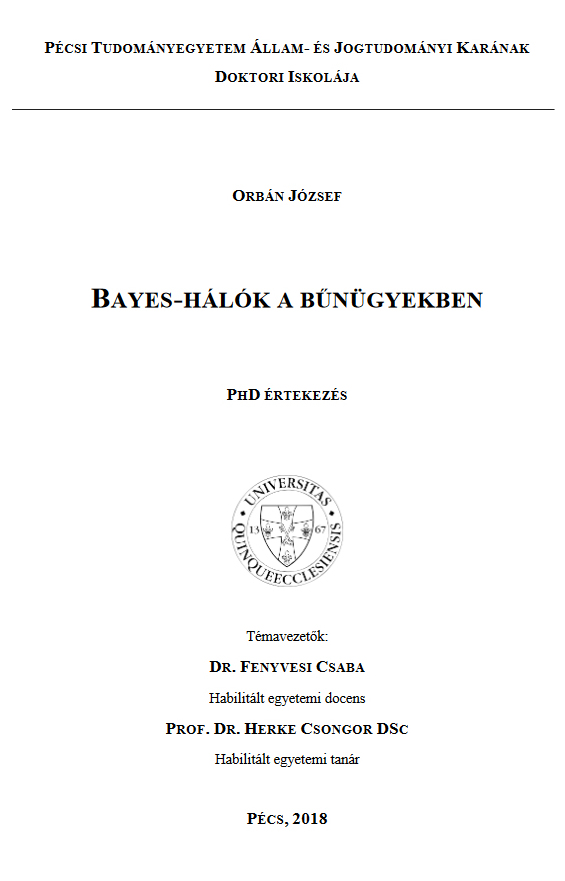Bayes-hálók a bűnügyekben
Abstract
A disszertáció bayesi valószínűségi megközelítésben vizsgálja a bűnügyekkel foglalkozó döntéshozók kihívásait. Az előzmények figyelembe vételével a bayesi valószínűség a valóság jelenre, vagy jövőre vetített bizonyosságát adja. A bűnügyek halmozott eshetőlegességet rejtő bizonyítékainak együttes és strukturált értékelésére javasolt módszer a Bayes-hálók alkalmazása. A büntetőeljárásban a Bayes-háló segítségével becsülhető a bizonyítékok együttes valóságtartalma, ami segíti a döntéshozatali folyamatot. A sorozatcselekmények valószínűségi modellezése a nyomozástól az elfogáson át a bizonyításig egyaránt segítséget nyújthat. A statisztikai adatokat is figyelembe vevő részletes, és a konkrét ügyre vetített valószínűségi elemzés segítséget nyújthat a tanú és külsérelmi nyomok nélküli halálesetek, így különösen a csecsemők hirtelen bölcsőhalála és az emberölés elhatárolásánál. A módszer használata egyaránt javasolt a nyomozó, az ügyész, a bíró és a védőügyvéd számára is. Az okos városok biztonságának tervezésénél a kriminológusok felhasználhatják a bűnügyi kockázatokat csökkentő javaslataik kidolgozásához. A disszertáció a valószínűségi elemzéseket egy hirtelen bölcsőhalál esetre és a rablási sorozatra vetítve mutatja be. A javaslat nem más eljárás helyettesítésére, hanem önálló módszerként alkalmazandó. Mellőzése akkor válhat jelentős kockázati tényezővé, amikor más módszer nem csökkenti a justizmord kockázatát. A justizmord elkerülése érdekében a sajátos szakértelmet kívánó módszer alkalmazásához indokolt egy bűnügyi matematikus – az evidenciárius – bevonása is.
||||||||||||||||||||||||||||||||||||||||||||||||||||||||||||||||||||||||||||||||||||||||||||||||||||||||||||||||||||||||||||||||||||||||||||||||||||||||||||||||||||||||||||||||||||||||||||
The dissertation explains that holistic probability aspect which providing support to all decision makers of the criminal processes, and in addition to these supports revealing of the truth with a paradigm shifting approach. Having the antecedents – a priori knowledge – the Bayesian probability provides a posteriori picture of the objective truth. The word subjective – in this context – means the bringing into focus a particular fact; therefore, all threats and believes in endangered truth based on the trivial usage of this adjective are gratuitous assumptions. The Bayesian Network is framing several uncertain elements of the reality into a unified structure. This method equally helps to fulfill the mission of serving the truth by the investigators, the prosecutor, the defendant and the judge. The uncertain knowledge may originate from the missing knowledge, the truth content fragmentation of facts, obliviscence of witnesses and some other reasons. The affidavit is being the topmost evidence till nowadays will be analyzed through a Bayesian Network measuring the factors affect the truth content of the testimony. The eyewitness testimony, being the most important type of evidences up to now during the trial, has been analyzed with a help of a Bayesian Network evaluating the influential facts of the truth content. The research beside of the analysis of Bayes Nets in forensic and penal law environment some new theoretical achievements on Bayesian Modelling and practical applications are presented as well. A detailed probabilistic and statistical analysis of delimitation of cot-death and child murder is also in the scope of dissertation. The method cannot be substituted by another one, therefore whenever it is required but not used the risk of miscarriage of justice is appeared. Instead of further increase the workload of the conventional actors of justice this approach involves a forensic mathematician expert: the evidentiary.

